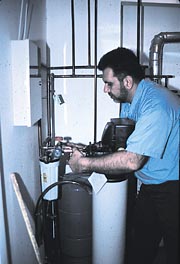
"Customer satisfaction is priority one," affirms Joe Grover, president/owner of All American H2O Inc., a 5-year-old, 42-employee firm with offices in Schaumburg and Wilmington, Ill. Having a good rapport with the homeowners can make a big difference and All American makes full use of a built-in advantage it possesses. "Our crews can speak between two and seven different languages," Grover explains. "We encounter very few language barriers." That certainly makes it easier to deal with today's increasingly diverse marketplace -- evidenced by Mikhail's adept handling of the thick Greek accent of this particular customer.
The customer had an iron problem and bad taste and odors in his water, and the unit he had was not suitably fitted. His son had a water treatment system installed 11 years ago and was extremely satisfied with its performance, so the customer decided to try that system -- the Apollo Gold water conditioning system from RainSoft, headquartered in Elk Grove Village, Ill. And if you want that system in Northern Illinois, you go through All American H2O. Grover notes that close to half of his company's business comes through referrals.
"We differentiate ourselves by providing a water treatment system, not just softeners," Grover says. "We treat the problem instead of masking it. The softeners are three-cycle systems; ours is a seven-cycle system."

How the System Works
Raw, untreated water enters a multi-cycle control valve and flows down through the resin tank. The water is filtered and softened as it passes through the ion exchange resin. An optional charcoal bed further polishes and clarifies the water. Once completely conditioned, the water exits the resin tank through the riser pipe and out the control valve, ready for use. The system regenerates at metered intervals. The retained foreign substances are flushed out of the system and down the drain. The unit then prepares itself for the next conditioning cycle.
"So the water entering the system already is treated," Grover explains. "One of the things we're well known for is that our systems will use up to 75 percent less sodium than conventional softeners. Therefore, there is less sodium getting into the drinking water. And the flow rate is 21 gallons per minute whereas a softener usually is somewhere between 8 gallons and 12 gallons per minute."

The Small Details
The customer wanted to keep his original unit hooked up as a backup. It was overkill as far as its function is concerned, but Mikhail emphasizes, "That's what he wanted, so that's what we did." And Grover discloses the real benefit of keeping the old unit intact: "Ninety-two percent of our customers who sell their homes exclude the system from the real estate contract and take it with them. They don't leave them behind because they know they work well and they have the lifetime warranty with it."Part of this particular job involved converting the drain pipe from 1?inch to 3?inch to get the system operating. "The installation he had before was illegal," remarks Grover. "So when we replaced the unit, we took the responsibility of making it legal."
Another little customer satisfying move involved the placement of the system's brine tank. "Because the unit was installed in a room that shared a wall with the garage, the brine tank was installed in the garage," Grover relates. "So instead of having to go through two different doors in the house to bring in the salt, the homeowner just backs in his car and the tank is right there. That's a nice convenience for him."

Sold on the System
Asked why this system comprises 99 percent of his installations, Grover provides a laundry list: "From a business standpoint, our service calls on the Gold Series is miniscule; they're trouble-free. Homeowners like it because there are only four buttons they have to deal with instead of eight or 10. The control valve is a microprocessor; you set it and forget it. It comes with as lithium battery so it never wears out. If there's a power outage, the system retains its memory. The composite valve is made of Noryl, a strong composite material that protects the valve against expansion and contraction due to pressure and temperature demands. It features a powerful high-torque motor that's self-lubricating and has power to spare, so we can offer the lifetime guarantee. The system has an automatic bypass during regeneration, so there's no chance of being without water or drawing salty water during the regeneration process. Our service is maybe 8 percent of our business, and that's because someone messed with the system.
"This is a treatment system. It's somewhat like a softener, but it's a lot more than just that; it goes way beyond that. Softening the water is the smallest thing our system will actually do. It will clarify and polish the water. It will remove up to three parts of iron and up to 90 percent of the barium in the water. It also will remove 80 percent to 90 percent of the radioactivity 226 and 228 -- a growing concern among people in this area."

Report Abusive Comment